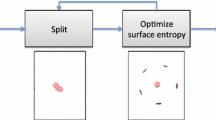Abstract
This paper compares several methods for obtaining sparse and compact point distribution models suited for data sets containing many variables. These are evaluated on a database consisting of 3D surfaces of a section of the pelvic bone obtained from CT scans of 33 porcine carcasses. The superior model with respect to sparsity, reconstruction error and interpretability is found to be a varimax rotated model with a threshold applied to small loadings. The models describe the biological variation in the database and are used for developing robotic tools when automating labor-intensive procedures in abattoirs.
Similar content being viewed by others
References
Alcantara, D, Carmichael, O., Delson, E., Harcourt-Smith, W., Sterner, K., Frost, S., Dutton, R., Thompson, P., Aizenstein, H., Lopez, O., Becker, J., Amenta, N.: Localized components analysis. In: Information Processing in Medical Imaging, IPMI, pp. 519–531 (2007)
Besl P.J., McKay N.D.: A method for registration of 3-D shapes. IEEE Trans. Pattern Anal. Mach. Intell. 14(2), 239–256 (1992)
Cadima J., Jolliffe I.T.: Loading and correlations in the inter- pretation of principle components. J. Appl. Stat. 22(2), 203–214 (1995)
Cootes T.F., Taylor C.J., Cooper D.H., Graham J.: Active shape models—their training and application. Comput. Vis. Image Underst. 61(1), 38–59 (1995)
Dryden I.L., Mardia K.V.: Statistical Shape Analysis. Wiley, New York (1998)
Gower J.C.: Generalized procrustes analysis. Psychometrika 40, 33–50 (1975)
Hayton J.C., Allen D.G., Scarpello V.: Factor retention decisions in exploratory factor analysis: a tutorial on parallel analysis. Organ. Res. Methods 7(2), 191–205 (2004)
Horn J.L.: A rationale and test for the number of factors in factor analysis. Psychometrika 30, 179–185 (1965)
Hyrvärinen A.: Survey on independent component analysis. Neural Comput. Surv. 2, 94–128 (1999)
Jackson J.E.: A User’s Guide to Principal Components. Wiley, New York (1991)
Kaiser H.F.: The varimax criterion for analytic rotation in factor analysis. Psychometrika 23, 187–200 (1958)
Lorensen, W.E., Cline, H.E.: Marching cubes: a high resolution 3D surface construction algorithm. In: SIGGRAPH '87: Proceedings of the 14th Annual Conference on Computer Graphics and Interactive Techniques, vol. 21, pp. 163–169. ACM Press, New York (1987)
Ólafsdóttir, H., Hansen, M.S., Sjöstrand, K., Darvann, T.A., Hermann, N.V., Oubel, E., Ersbøll, B.K., Larsen, R., Frangi, A.F., Larsen, P., Perlyn, C.A., Morriss-Kay, G.M., Kreiborg, S.: Sparse statistical deformation model for the analysis of craniofacial malformations in the crouzon mouse. In: Scandinavian Conference on Image Analysis, vol. 4522, pp. 112–121. Springer, Berlin (2007)
Rathi, Y., Dambreville, S., Tannenbaum, A.: Statistical shape analysis using kernel pca. In: SPIE International Symposium on Medical Imaging 2006, vol. 6064, p. 60641B (2006)
Rusinkiewicz, S., Levoy, M.: Efficient variants of the ICP algorithm. In: Proceedings of the Third International Conference on 3D Digital Imaging and Modeling, pp. 145–152 (2001)
Sjöstrand, K., Stegmann, M.B., Larsen, R.: Sparse principal component analysis in medical shape modeling. In: SPIE International Symposium on Medical Imaging 2006, vol. 6144 (2006)
Stegmann M.B., Ersbøll B.K., Larsen R.: FAME—a flexible appearance modelling environment. IEEE Trans. Med. Imaging 22(10), 1319–1331 (2003)
Stegmann, M.B., Sjöstrand, K., Larsen, R.: Sparse modeling of landmark and texture variability using the orthomax criterion. In: SPIE International Symposium on Medical Imaging 2006, vol. 6144 (2006)
Turk G., O’Brien J.F.: Shape transformation using variational implicit functions. Comput. Graph. 33, 335–342 (1999)
Zou H., Hastie T., Tibshirani R.: Sparse principal component analysis. J. Comput. Graph. Stat. 15(2), 265–286 (2006)
Author information
Authors and Affiliations
Corresponding author
Rights and permissions
About this article
Cite this article
Erbou, S.G.H., Vester-Christensen, M., Larsen, R. et al. Comparison of sparse point distribution models. Machine Vision and Applications 21, 999–1008 (2010). https://doi.org/10.1007/s00138-009-0203-1
Received:
Revised:
Accepted:
Published:
Issue Date:
DOI: https://doi.org/10.1007/s00138-009-0203-1




